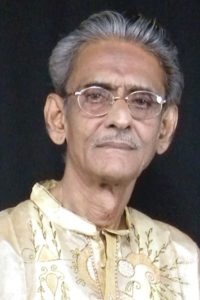Govt Should Take Active Interest To Revive Odisha’s ‘Mogul Tamasha’, Says Exponent Badal Sikdar

Odisha’s unique Mogul Tamasha occupies a place of pride on the theatre-map of India. Created nearly 250 years ago, this folk theatre form is found only in and around Bhadrak town.
Known for its synthesis of Hindu-Muslim culture and brotherhood, it has been declared as a ‘dying’ arts tradition by the Government of India.
However, if this unique art form is known beyond Bhadrak, it has been largely due to four decades of a committed campaign by Bhadrak’s Badal Sikdar who is the best-known exponent of the tradition today.
Even at 80, he is quite active as a Natya-Guru, a title conferred by the Central Government, apart from a researcher and promoter of Mogul Tamasha.
Excerpts from an interview:

Who is the creator of Mogul Tamasha?
Poet Bansi Ballav Goswami of Sangat village near Bhadrak town was the creator of seven types of Tamasha (play of farce) in the second half of the 18th century. Mogul Tamasha is one of them that has survived the onslaught of the changing taste and time.
Why has Mogul Tamasha been so popular?
Usually, Tamasha enjoyed mass appeal in India because of its comedy and social satire apart from the highly entertaining elements of folk arts. Mogul Tamasha enjoyed more popularity and survived the changing taste of the audience and of the times because of its inherent synthesis of the Hindu and Muslim culture. It further celebrated the long-drawn Hindu-Muslim brotherhood of Bhadrak. So, its mass appeal remained intact.
Why is it confined to Bhadrak?
The people of Bhadrak town and its surrounding villages took pride in the tradition of the arts as their very own. They patronized it. It was an important annual ritual for them as an integral part of the annual Chaiti Jata (happening in the month of Chaitra in front of Shiv temples of the villages). The play was a reflection of the social reality of their region that was ruled by the Moguls for a very long time. Mogul Tamasha is a complex art form that demands rigorous and continued training by exponents who were based in these villages. For these factors, it continued in and around Bhadrak as a tradition and did not spread beyond.
Why did Mogul Tamasa become a ‘dying’ arts tradition?
Any arts tradition requires public patronage for its survival. With the advent of the modern modes of entertainment like cinema and television along with rapid urbanization resulting in the shrinking of village culture, Mogul Tamasha lost its strong support base. While public patronage was decreasing, the government hardly did anything to save it from ‘dying’. I strongly feel that the apathy of the people of Bhadrak, with whose mass support Mogul Tamasa had grown, is responsible for its decay.
How did you get involved in Mogul Tamasha?
I was into theatre since childhood. My grandfather was a famous Keertan-singer and my father was in the theatre. I was born in Bhadrak that was culturally vibrant. Similarly, my maternal grandfather was the famous poet Krushna Prasad Basu of Jajpur. I lived at his place for my schooling. Later on, I used to visit Kolkata frequently where my father’s sister was based. Kolkata was agog with theatre culture then. Thus, it was natural for someone like me, who was so passionate and involved with theatre, to be drawn towards this unique folk theatre of my hometown.
What challenges did you face as an exponent?
Challenges were many but were worth facing to revive the glory of Mogul Tamasha. However, my venture with the introduction of females as actors was the biggest challenge that I had faced. Many people including Mogul Tamasha experts and artistes were against my venture. But I felt that female actors were appropriate to enact female characters instead of men acting like women.
What suggestions do you have for the promotion of Mogul Tamasha?
It needs the urgent intervention of the Department of Culture of our state for its survival. The number of Mogul Tamasha troupes have come down from 12 to just four because of a lack of adequate platforms. This unique art of Odisha should be duly highlighted through proper publicity across India and even abroad; so that the troupes get invitations to perform. The government should also establish a Mogul Tamasha research and training center at Bhadrak without further delay for its documentation, research, and promotion.
Bhadrak has witnessed Hindu-Muslim conflicts at times. Have such clashes affected the age-old Hindu-Muslim brotherhood of Mogul Tamasha?
No. Bhardak’s communal harmony is very strong. Conflicts have been sporadic and they have never affected the intimate involvement of both the communities in Mogul Tamasha. I staged a show at Bhadrak recently and more than two-thirds of the audience were Muslim women. This proves that Mogul Tamasha belongs to the people of Bhadrak and not to a particular community.
Also Read: Odisha MP-Actor Anubhav Mohanty Thanks ‘Anchor’ Jagrati Shukla For Being A Friend In Need!

Comments are closed.